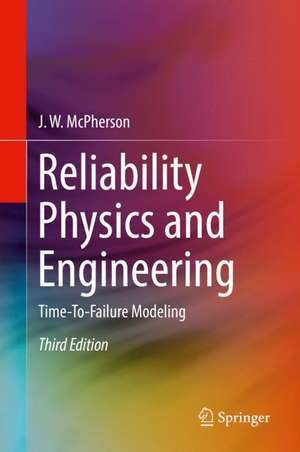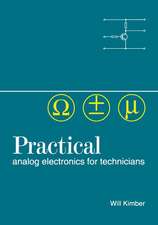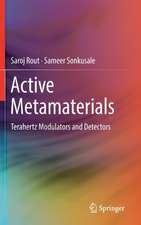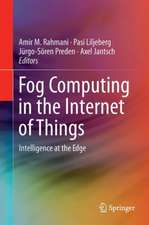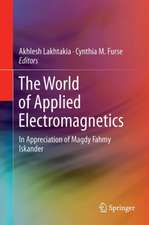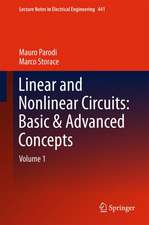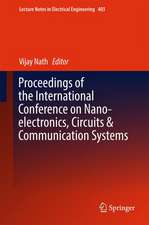Reliability Physics and Engineering: Time-To-Failure Modeling
Autor J. W. McPhersonen Limba Engleză Hardback – 10 ian 2019
| Toate formatele și edițiile | Preț | Express |
|---|---|---|
| Paperback (1) | 589.84 lei 6-8 săpt. | |
| Springer International Publishing – 9 iul 2015 | 589.84 lei 6-8 săpt. | |
| Hardback (1) | 712.36 lei 6-8 săpt. | |
| Springer International Publishing – 10 ian 2019 | 712.36 lei 6-8 săpt. |
Preț: 712.36 lei
Preț vechi: 838.08 lei
-15% Nou
Puncte Express: 1069
Preț estimativ în valută:
136.32€ • 141.52$ • 113.67£
136.32€ • 141.52$ • 113.67£
Carte tipărită la comandă
Livrare economică 25 martie-08 aprilie
Preluare comenzi: 021 569.72.76
Specificații
ISBN-13: 9783319936826
ISBN-10: 3319936824
Pagini: 318
Ilustrații: XVII, 463 p. 207 illus., 164 illus. in color.
Dimensiuni: 155 x 235 x 29 mm
Greutate: 0.85 kg
Ediția:3rd ed. 2019
Editura: Springer International Publishing
Colecția Springer
Locul publicării:Cham, Switzerland
ISBN-10: 3319936824
Pagini: 318
Ilustrații: XVII, 463 p. 207 illus., 164 illus. in color.
Dimensiuni: 155 x 235 x 29 mm
Greutate: 0.85 kg
Ediția:3rd ed. 2019
Editura: Springer International Publishing
Colecția Springer
Locul publicării:Cham, Switzerland
Cuprins
Introduction.- Physics of Degradation.- Time Dependence of Materials and Device Degradation.- From Material/Device Degradation to Time-To-Failure.- Time-To-Failure Modeling.- Gaussian Statistics - An Overview.- Time-To-Failure Statistics.- Failure Rate Modeling.- Accelerated Degradation.- Acceleration Factor Modeling.- Ramp-To-Failure Testing.- Time-To-Failure Models for Selected Failure Mechanisms in Integrated Circuits.- Time-To-Failure Models for Selected Failure Mechanisms in Mechanical Engineering.- Conversion of Dynamical Stresses Into Effective Static Values.- Resonance and Resonance-Induced Degradation.- Increasing the Reliability of Device/Product Designs.- Screening.- Heat Generation and Dissipation.- Sampling Plans and Confidence Intervals.-
Recenzii
“Reliability Physics and Engineering: Time-to-Failure Modeling … presents good technical insights into advance reliability physics theories and modeling, suitable for both industry and academic practitioners. The authors provide insights into the broad values and technical applications of reliability and safety engineering in this book. … Valuable as a learning tool reliability physics and modeling, its clear relevance to real-world industry practices make it useful for both academics and semiconductor industry practitioners.” (Chong Leong Gan, Life Cycle Reliability and Safety Engineering, Vol. 9, 2020)
Notă biografică
J.W. McPherson is recognized internationally as an expert in Reliability Physics & Engineering. He has published over 200 papers on reliability, authored the Reliability Chapters for 4 Books, awarded 15 patents, and holds the title of Texas Instruments Senior Fellow Emeritus. He was the 1995 General Chairman of the IEEE International Reliability Physics Symposium and still serves on its Board of Directors. In 2004, Joe received the IEEE Engineer of the Year Award from the Texas Society of Professional Engineers. In 2006, he was the Chairman of the International Sematech Reliability Council. Joe is an IEEE Fellow and the Founder/CEO of McPherson Reliability Consulting, LLC. His semiconductor reliability expertise includes device-physics, design-in reliability, wafer-fabrication and assembly-related reliability issues. Several of the reliability models that are used today in the semiconductor industry are closely associated with his name.
Textul de pe ultima copertă
This third edition textbook provides the basics of reliability physics and engineering that are needed by electrical engineers, mechanical engineers, civil engineers, biomedical engineers, materials scientists, and applied physicists to help them to build better devices/products. The information contained within should help all fields of engineering to develop better methodologies for: more reliable product designs, more reliable materials selections, and more reliable manufacturing processes— all of which should help to improve product reliability. A mathematics level through differential equations is needed. Also, a familiarity with the use of excel spreadsheets is assumed. Any needed statistical training and tools are contained within the text. While device failure is a statistical process (thus making statistics important), the emphasis of this book is clearly on the physics of failure and developing the reliability engineering tools required for product improvements during device-design and device-fabrication phases.
- Provides a comprehensive textbook on reliability physics of semiconductors, from fundamentals to applications;
- Explains the fundamentals of reliability physics and engineering tools for building better products;
- Contains statistical training and tools within the text;
- Includes new chapters on Physics of Degradation, and Resonance and Resonance-Induced Degradation.
Caracteristici
Provides a comprehensive textbook on reliability physics of semiconductors, from fundamentals to applications; Explains the fundamentals of reliability physics and engineering tools for building better products; Contains statistical training and tools within the text; Includes new chapters on Physics of Degradation, and Resonance and Resonance-Induced Degradation.
